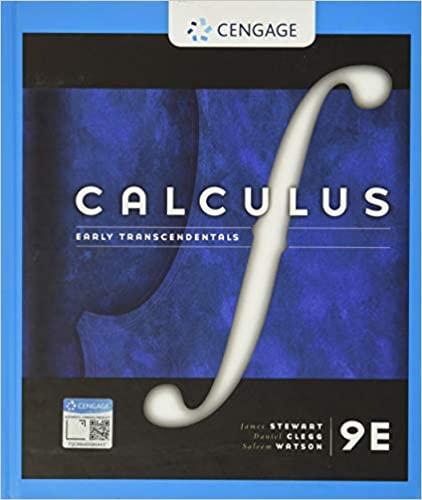Question
Please I need help to understand how this is done. I have tried it but there is issue with my graph. clc clear A1=5 A2=5
Please I need help to understand how this is done. I have tried it but there is issue with my graph.
clc
clear
A1=5
A2=5
f1=100
f2=100
sphase=0
bphase=0
t=0:0.0001:0.01
s=A1*sin((2*pi*f1*t)+sphase)
b=A2*cos((2*pi*f2*t)+bphase)
yyaxis left %this command places the y scale on the left side
plot(t,s)
yyaxis right %this command places the y scale on the right side
plot(t, b)
title('Sine and Cosine Waveforms')
Step 1.9 Using the MatLab code in step 1.8, modify the sine sphase, by +90 degrees or +pi/2 radians, and keep the cosine wave, bphase, at 0 degrees phase angle.
Question 1.9 Select the best answer regarding your observation from step 1.9.
a. both s(t) and b(t) appear as identical sine waves
b. both s(t) and b(t) appear as identical cosine waves
c. s(t) appears as a sine wave while b(t) appears as a cosine wave
d. s(t) appears as a cosine wave while b(t) appears as a sine wave
Step 1.10 Now try plotting the following carrier waves with a(t) appearing on the left and b(t) appearing on the right. Place both plots onto a single graph as you did in steps 1.8 and 1.9.
a(t) = 3cos(2250t - /4) b(t) = 4cos(500t + )
Question 1.10 What are the differences between the two plots a(t) and b(t) from step 1.10?
a. plots are different in amplitude
b. plots are different in frequency
c. plots are different in phase
d. both a and b
e. both a and c
f. a, b, and c
Step 1.11 Set the phase angle of both sinusoidal equations to =0 radians.
Question 1.11 If you set the phase angle of both sinusoids to 0, what would be the difference(s) between the wave forms?
a. plots are same in amplitude
b. plots are different in frequency
c. plots show the difference in phase angles between sine and cosine waves
d. both a and b
2.0 Amplitude Modulation
message or modulating signal: m(t) = Amcos(2fmt)
carrier: c(t) = Ac cos(2fct)
modulation index: = Am/Ac, where 01
AM modulation formula: s(t) = Ac[1 + cos(2fmt)] cos(2fct)
Plot the following equations: m(t) = 4cos(2*1800Hz*t)
c(t) = 5cos(2*10.5kHz*t)
= 4/5 = 0.8
s(t) = 5[1 + 0.8cos(2*1800Hz*t)]cos(2*10.5kHz*t)
Step 2.1
%AM Modulation;
clear;
Ac=5;
Am=4;
fc=10500;
fm=1800;
t=0:0.00001:0.003;
m=Am*cos(2*pi*fm*t);
c=Ac*cos(2*pi*fc*t);
mi = Am/Ac;
s=Ac*(1+mi*cos(2*pi*fm*t)).*cos(2*pi*fc*t);
subplot(2,2,1);
plot(t,s);
xlabel('time');
ylabel('amplitude');
title('AM modulation');
subplot(2,2,4);
plot(t,m);
xlabel('time');
ylabel('amplitude');
title('Message');
subplot(2,2,2);
plot (t,c);
xlabel('time');
ylabel('amplitude');
title('Carrier');
Definition of above MATLAB formula:
Ac: carrier amplitude
Am: modulating signal's amplitude
fc : carrier wave frequency in Hertz
fm: modulating wave frequency in Hertz
t: time range in seconds (start time 0 seconds, at 0.00001 second intervals, end time 0.003 seconds)
m: formula for the modulating signal
c: formula for the carrier wave
mi: AM modulation index
s: resulting modulated carrier wave or signal wave form
Step 2.4 Select the "Run" icon. Another window should open (fig.1) showing graphical plots for the modulated carrier wave or signal, and the message or modulating wave.
Fig 1. AM Modulation. The top left graph depicts the modulated signal wave 's'. Top right graph depicts the carrier wave. The lower right graph depicts the message or modulating wave form.
Note1: If you do not see the figure above after you have executed the code, then re-check your code.
Question 2.4 The signal, s(t), shows signal distortion and the receiver will be unable to recover the transmitted message
a. True
b. False VLAB v13 9
Step 2.5 Now change the message amplitude, Am, to 100 and plot signal. Answer the following question.
Question 2.5 Having changed the message amplitude to Am=100, select the correct statement
a. The signal, s(t), will be received without distortion because the frequency of the signal is between 0 and 1
b. The signal, s(t), will be received without distortion because the AM Modulation Index of the signal is between 0 and 1
c. The signal, s(t), will be received without distortion because the amplitude of the carrier is too high
d. The signal, s(t), will be distorted because the AM modulation index is not within the required range: 01
Step 2.6 Next, change the frequency of the message to fm=500 and the message amplitude to Am=5.
Question 2.6 Select the correct statement that describes what you see in the plots:
a. The signal, s(t), is distorted by the dramatic change in message frequency.
b. The message amplitude change can be seen in the signal plot of s(t). When comparing plots for s(t) and m(t), it is obvious that the signal accurately represents the message.
c. Both the message and carrier frequencies increase, therefore distortion will be experienced.
d. The phase of the signal has shifted to the right, because AM techniques impact phase and amplitude.
Step by Step Solution
There are 3 Steps involved in it
Step: 1

Get Instant Access to Expert-Tailored Solutions
See step-by-step solutions with expert insights and AI powered tools for academic success
Step: 2

Step: 3

Ace Your Homework with AI
Get the answers you need in no time with our AI-driven, step-by-step assistance
Get Started


